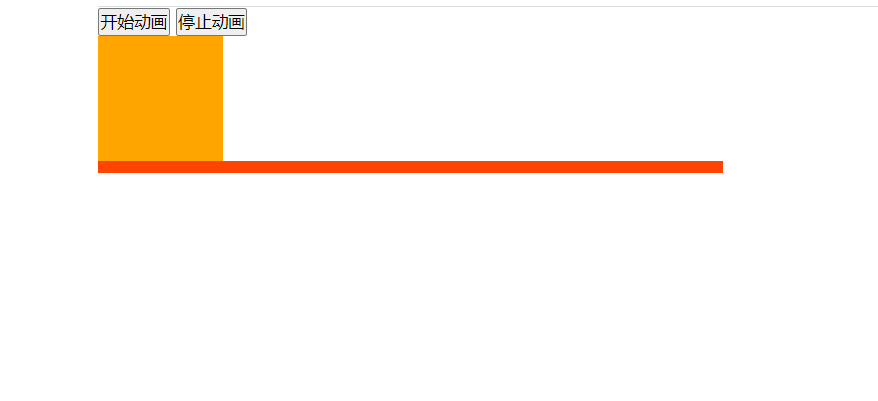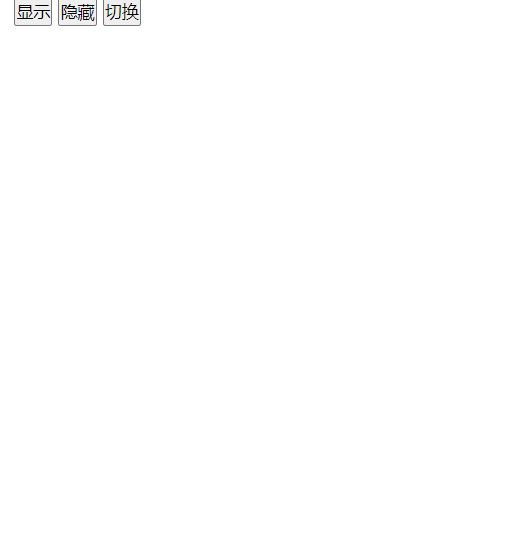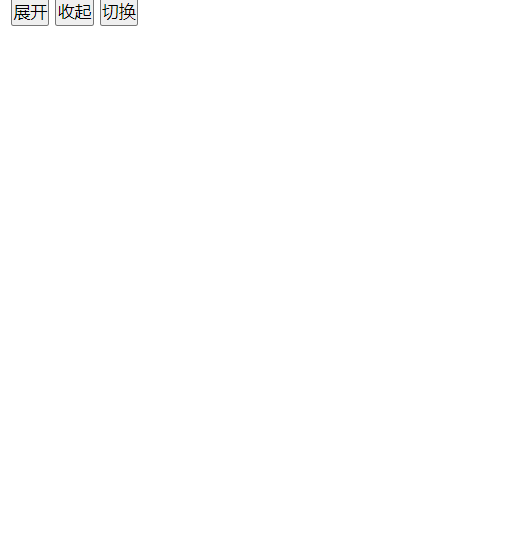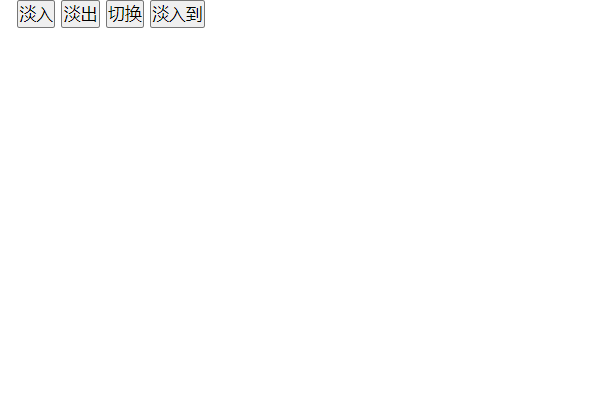目录
一、自定义动画
1.1 animate()
1.2 animate()动画执行顺序
1.3 animate()动画回调函数和匀速运动
1.4 animate动画之stop()/delay()
二、动画
2.1 show()/hide()/toggle()
2.2 slideDown()/slideUp()/slideToggle()
2.3 fadeIn()/fadeOut()/fadeTo()/fadeToggle()
一、自定义动画
1.1 animate()
描述:jq对象的自定义动画
语法:jq对象.animate(JSON格式的参数,动画执行时间ms,["linear"/"swing"],fn)
参数:它有四个参数
- 第一个参数是JSON,表示动画的终点(就是这个函数要变成什么样子)即CSS样式
- 第二个参数是动画执行完毕所需的时间
- 第三个参数是指定动画节奏,也就是速度变化,比如:linear
- 第四个参数是自定义动画执行完毕之后的回调函数
注意:即使只有一个属性发生动画,也要写JSON,而不能写k,v形式
例如:
<script>
$("div").animate({"left": 300,"top": 200,"right": 50},2000,function() {
//自定义动画执行完毕之后的回调函数
});
</script>例子1:
公共部分:
<style>
div {
width: 100px;
height: 100px;
background-color: orange;
position: absolute;
}
</style><div></div><script>
$('div').click(function() {
// 向右移动
$(this).animate({
"left": 800,
// "width": "hide/toggle", 关键字
"width": "200px",
"height": "200px",
"top": 100
}, 2000)
.animate({ //向左移动
"left": 0,
"width": "100px",
"height": "100px",
"top": 0,
"opacity": 0.5
}, 2000);
})
</script>
当点击div区域后:


局限性:animate()能够改变的是量化的属性
例子:
<script>
$("div").animate({
"background-color": "blue"
}, 2000);
</script>
- 执行结果发现div的背景颜色并没有在2秒钟内发生一个动画变化。所以很显然jQuery对于相当一部分的属性是不能够进行动画的。至少现在不行。而我们今天并不关心什么属性能动画,我们关心的是不能变化的属性:background-color、background-position不能参与动画!!!
- jQuery能够改变的属性都是数值型的,比如width、height、font-size、opacity等
1.2 animate()动画执行顺序
jq中动画的执行遵循两大原则:
公共部分:
<style>
div {
width: 100px;
height: 100px;
background-color: orange;
position: absolute
}
.div2 {
top: 150px;
}
</style><div class="div1"></div>
<div class="div2"></div>- 同步原则:同一个元素如果存在多个animate命令,则按照添加顺序执行
<script>
$('div').animate({
"left": 800
}, 2000)
.animate({
"width": 200
}, 2000)
.animate({
"height": 200
}, 2000);
</script>

- 异步原则:不同元素如果存在多个animate命令,则他们同时执行
<script>
$('.div1').animate({
"left": 800
}, 2000);
$('.div2').animate({
"left": 800
}, 2000);
</script>
注意:
一个animate完成动画效果和多个animate分别完成动画效果完全不等价
<script>
//执行2000ms
$('div').animate({
"left": 800,
"width": 200,
"height": 200
}, 2000);
//不等价
//执行6000ms
$('div').animate({
"left": 800
}, 2000)
.animate({
"width": 200
}, 2000)
.animate({
"height": 200
}, 2000);
</script>例子:
<script>
$('div').animate({
"left": 800
}, 600)
.animate({
"top": 400
}, 600)
.animate({
"left": 100
}, 600)
.animate({
"top": 100
}, 600)
.slideUp()
.fadeIn();
</script>1.3 animate()动画回调函数和匀速运动
公共部分:
<script src="js/jquery-1.12.3.min.js"></script>
<style>
div {
width: 100px;
height: 100px;
background-color: orange;
position: absolute
}
.div2 {
top: 150px;
}
</style><div class="div1"></div>
<div class="div2"></div>1.回调函数(可选参数)
描述:表示animate执行完之后,要干什么
在回调函数中 $(this) 指的是运动的对象
<script>
$('div').animate({
"left": 800
}, 5000, function() {
$(this).css("background-color", "blue");
});
</script>

2.匀速运动(可选参数)
描述:jQuery的运动不是匀速的,而是先加速然后到终点缓慢减速。
那么我们如果想进行匀速运动,就需要加一个参数叫做"linear"(线性的)。
<script>
$('.div1').animate({
"left": 800
}, 3000, function() {
$(this).css("background-color", "blue");
});
$('.div2').animate({
"left": 800
}, 3000, "linear", function() {
$(this).css("background-color", "blue");
});
</script>1.4 animate动画之stop()/delay()
公共部分:
<script src="js/jquery-1.8.3.js"></script>* {
margin: 0;
padding: 0;
}
.one {
width: 100px;
height: 100px;
background: orange;
}
.two {
width: 500px;
height: 10px;
background: #f40;
}<button>开始动画</button>
<button>停止动画</button>
<div class="one"></div>
<div class="two"></div>1.4.1 delay()
用于高速度系统动画延迟时长
$(function() {
$("button").eq(0).click(function() {
$(".one").animate({
width: 400,
}, 1000).delay(1000).animate({
height: 260
});
});
$("button").eq(1).click(function() {});
});
1.4.2 stop()
stop(clearAllAnimation,goToEnd)
说明:
- 第一个参数表示是否清除所有动画,默认为false表示不清除所有动画(只清除当前动画)
- 第二个参数表示是否瞬间完成当前动画(达到动画结束的状态),默认为false表示不立即完成当前动画
$(function() {
$("button").eq(0).click(function() {
$(".one").animate({
width: 400,
}, 1000)
$(".one").animate({
height: 260
}, 1000)
$(".one").animate({
width: 100,
}, 1000)
$(".one").animate({
height: 100,
}, 1000);
});
$("button").eq(1).click(function() {
// $("div").stop(); //立即停止当前动画,继续执行后续动画
// $("div").stop(false); //立即停止当前动画,继续执行后续动画
// $("div").stop(false, false); //立即停止当前动画,继续执行后续动画
// $("div").stop(true); //立即停止当前和后续所有的动画
// $("div").stop(true, false); //立即停止当前和后续所有的动画
// $("div").stop(false, true); //立即停止当前动画,继续执行后续动画
$("div").stop(true, true); //立即完成当前动画,并且停止后续动画
});
});二、动画
<script src="js/jquery-1.8.3.js"></script>2.1 show()/hide()/toggle()
都可接收两个参数,第一个参数表示执行所需的时间单位为毫秒;第二个参数表示执行完毕之后的回调函数
* {
margin: 0;
padding: 0;
}
div {
width: 200px;
height: 200px;
background: orange;
display: none;
}<button>显示</button>
<button>隐藏</button>
<button>切换</button>
<div></div>$(function() {
//显示
$("button").eq(0).click(function() {
$("div").show(1000, function() {
//动画执行完毕之后调用
});
});
//隐藏
$("button").eq(1).click(function() {
$("div").hide(1000, function() {
//动画执行完毕之后调用
});
});
//切换
$("button").eq(2).click(function() {
$("div").toggle(1000, function() {
//动画执行完毕之后调用
});
});
});
2.2 slideDown()/slideUp()/slideToggle()
都可接收两个参数,第一个参数表示执行所需的时间单位为毫秒;第二个参数表示执行完毕之后的回调函数
* {
margin: 0;
padding: 0;
}
div {
width: 200px;
height: 200px;
background: orange;
display: none;
}<button>展开</button>
<button>收起</button>
<button>切换</button>
<div></div>$(function() {
//显示
$("button").eq(0).click(function() {
$("div").slideDown(1000, function() {
//动画执行完毕之后调用
});
});
//隐藏
$("button").eq(1).click(function() {
$("div").slideUp(1000, function() {
//动画执行完毕之后调用
});
});
//切换
$("button").eq(2).click(function() {
$("div").slideToggle(1000, function() {
//动画执行完毕之后调用
});
});
});
2.3 fadeIn()/fadeOut()/fadeTo()/fadeToggle()
* {
margin: 0;
padding: 0;
}
div {
width: 200px;
height: 300px;
background: red;
display: none;
}<button>淡入</button>
<button>淡出</button>
<button>切换</button>
<button>淡入到</button>
<div></div>$(function() {
//淡入
$("button").eq(0).click(function() {
$("div").fadeIn(1000, function() {});
});
//淡出
$("button").eq(1).click(function() {
$("div").fadeOut(1000, function() {});
});
//切换
$("button").eq(2).click(function() {
$("div").fadeToggle(1000, function() {});
});
//淡入到
$("button").eq(3).click(function() {
$("div").fadeTo(1000, 0.5, function() {});
});
});
轮播图示例:
<!DOCTYPE html>
<html lang="en">
<head>
<meta charset="UTF-8" />
<meta http-equiv="X-UA-Compatible" content="IE=edge" />
<meta name="viewport" content="width=device-width, initial-scale=1.0" />
<title>Document</title>
<style>
* {
padding: 0;
margin: 0;
}
ul,
li {
list-style: none;
}
/* 轮播图 */
.banner {
width: 650px;
height: 360px;
margin: 20px auto;
overflow: hidden;
position: relative;
}
.banner ul {
width: 4000px;
height: 360px;
display: flex;
}
.banner > img {
vertical-align: bottom;
}
/* 左右切换按钮 */
.toggle {
position: absolute;
width: 100%;
left: 0;
top: 50%;
transform: translateY(-50%);
display: flex;
justify-content: space-between;
}
/* 设置左右按钮的样式 */
.toggle span {
display: inline-block;
width: 30px;
height: 60px;
background: rgba(0, 0, 0, 0.5);
line-height: 60px;
text-align: center;
font-size: 40px;
color: #fff;
}
/* 设置左右按钮的 hover 效果 */
.toggle span:hover {
cursor: pointer;
background: rgb(231, 140, 20);
}
/* 指示点 */
.point {
width: 50%;
height: 20px;
position: absolute;
bottom: 20px;
left: 45%;
z-index: 999;
display: flex;
justify-content: space-between;
}
.point div {
width: 10%;
height: 20px;
background-color: aquamarine;
border-radius: 10px;
cursor: pointer;
}
.point .active {
background-color: #f40;
width: 15%;
}
</style>
</head>
<body>
<div class="banner">
<ul class="ul">
<li><img src="images/beijing/0.jpg" alt="" /></li>
<li><img src="images/beijing/1.jpg" alt="" /></li>
<li><img src="images/beijing/2.jpg" alt="" /></li>
<li><img src="images/beijing/3.jpg" alt="" /></li>
<li><img src="images/beijing/4.jpg" alt="" /></li>
<li><img src="images/beijing/0.jpg" alt="" /></li>
</ul>
<!-- 左右切换按钮 -->
<div class="toggle">
<span id="pre"><</span>
<span id="next">></span>
</div>
<!-- 指示点 -->
<div class="point">
<div data-id="0" class="active"></div>
<div data-id="1"></div>
<div data-id="2"></div>
<div data-id="3"></div>
<div data-id="4"></div>
</div>
</div>
<script src="../Jquery/jquery-3.6.0.js"></script>
<script>
// 0. 用来表示目前正在查看的图片序号
let index = 0;
// 1. 设置定时器,让 ul 在 1000ms 内向左移动一定距离
let timer = setInterval(lunbo, 1000);
// 封装轮播函数
function lunbo() {
// 当前轮播图片为最后一张时,让当前的图片变为第一张即index=0
index++;
let left = -index * 650 + "px";
// 将所有的 div 都恢复为原来的背景色
$(".point div")
.css("backgroundColor", "aquamarine")
.animate({ width: "10%" }, 100);
// 通过 index 去设置当前 指示点 的背景颜色
$(`.point div:eq(${index == 5 ? 0 : index})`)
.css("backgroundColor", "#f40")
.animate({ width: "15%" }, 100);
/**
* 当 index 为 4 时,我们需要正常去进行加加,加到5
* 使其切换到下一张,切换到下一张这个动画效果在完毕之后
* 我们应该使整个ul的margin-left变为0
*/
$(".ul").animate({ marginLeft: left }, 500, function () {
if (index == 5) {
$(".ul").css("marginLeft", "0px");
index = 0;
}
});
}
/**
* 2.
* 当鼠标移动到图片上时,图片暂停轮播
* 当鼠标移开时,轮播继续
*/
$(".banner").mouseenter(function () {
clearInterval(timer);
});
$(".banner").mouseleave(function () {
timer = setInterval(lunbo, 1000);
});
/**
* 3.
* 给指示点添加点击事件
*/
$(".point div").click(function () {
let id = parseInt($(this).attr("data-id"));
// 将 id 赋值给 index,这样下一张的切换才能接着上一张进行
index = id;
let left = -index * 650 + "px";
$(".ul").animate({ marginLeft: left }, 500);
// 将所有的 div 都恢复为原来的背景色
$(".point div")
.css("backgroundColor", "aquamarine")
.animate({ width: "10%" }, 100);
// 通过 index 去设置当前 指示点 的背景颜色
// $(`.point div:eq(${index})`).css(
// "backgroundColor",
// "#f40"
// ); 或
$(this).css("backgroundColor", "#f40").animate({ width: "15%" }, 100);
});
/**
* 4. 点击 左 按钮进行切换
*/
$("#pre").click(function () {
index--;
// console.log(index); // -1
if (index < 0) {
index = 4;
$(".ul").css("marginLeft", (-index * 650) + "px" );
}
let left = -index * 650 + "px";
$(".ul").animate({ marginLeft: left }, 500);
$(".point div")
.css("backgroundColor", "aquamarine")
.animate({ width: "10%" }, 100);
$(`.point div:eq(${index})`)
.css("backgroundColor", "#f40")
.animate({ width: "15%" }, 100);
});
/**
* 5. 点击 右 按钮进行切换
*/
$("#next").click(function () {
index++;
if (index == 5) {
$(".ul").css("marginLeft", "0px");
index = 0;
}
let left = -index * 650 + "px";
$(".ul").animate({ marginLeft: left }, 500);
$(".point div")
.css("backgroundColor", "aquamarine")
.animate({ width: "10%" }, 100);
$(`.point div:eq(${index})`)
.css("backgroundColor", "#f40")
.animate({ width: "15%" }, 100);
});
</script>
</body>
</html>



















